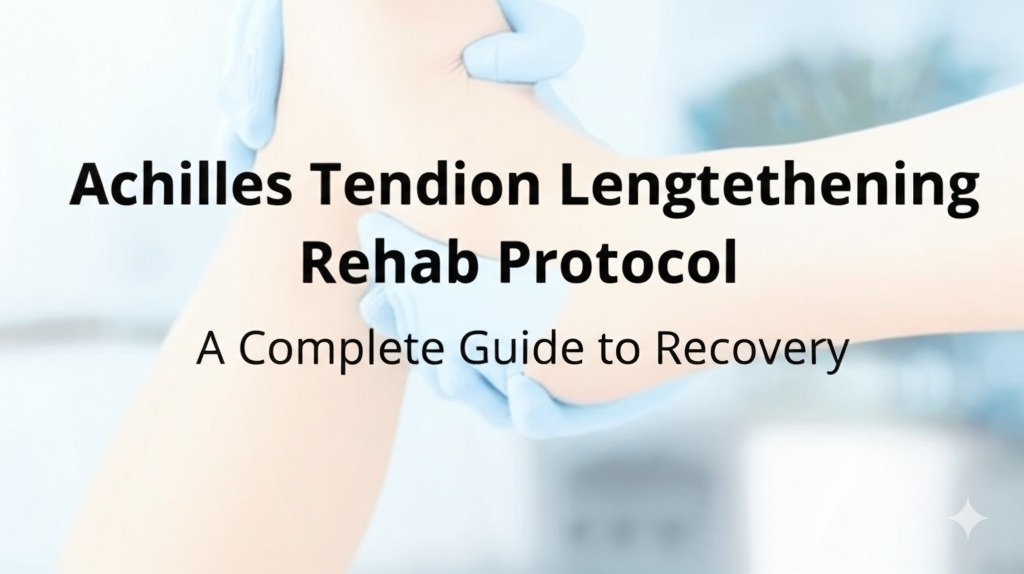Introduction: Regaining Strength Step by Step
Achilles tendon lengthening (ATL) is a surgical procedure often performed to treat conditions like cerebral palsy, equinus deformity, or chronic Achilles tendinopathy. Whether due to a medical condition or injury, recovering from this procedure requires a carefully structured rehabilitation protocol. Understanding the Achilles tendon lengthening rehab protocol is crucial for patients, caregivers, and healthcare professionals alike. In this guide, we break down each phase of the recovery process, offering insight, timelines, and best practices for a smooth and effective recovery.
Phase 1: Immediate Post-Operative Period (Weeks 0-2)
Goals:
- Protect the surgical site
- Control pain and swelling
- Begin gentle mobility
Key Protocols:
- Immobilization: The foot is typically placed in a cast or boot in a plantarflexed (toes pointed down) position.
- Non-weight bearing: Crutches or a walker are required.
- Pain management: Medication and elevation to reduce inflammation.
- Initial movement: Gentle toe wiggling to promote circulation.
Pro Tip: Elevate the leg above heart level as often as possible to minimize swelling.
Phase 2: Early Mobility and Transition (Weeks 2-6)
Goals:
- Begin gentle range-of-motion (ROM) exercises
- Prevent muscle atrophy
- Maintain cardiovascular fitness (upper body)
Key Protocols:
- Partial weight bearing: As guided by the surgeon, transitioning into a walking boot.
- ROM exercises: Dorsiflexion and plantarflexion within safe limits.
- Therapeutic modalities: Ice, electrical stimulation, and gentle massage.
- Stationary cycling: With no resistance to maintain general fitness.
Important: Avoid overstretching the tendon—gradual progress is key.
Phase 3: Progressive Strengthening and Mobility (Weeks 6-12)
Goals:
- Restore full range of motion
- Rebuild strength and balance
- Normalize gait pattern
Key Protocols:
- Weight-bearing as tolerated: Transitioning out of the walking boot.
- Strengthening exercises:
- Calf raises (seated then standing)
- Theraband resistance work
- Ankle stability drills
- Stretching: Gentle calf and hamstring stretches
- Gait training: Under the guidance of a physical therapist
Tip: Consistency with exercises improves outcomes and reduces risk of re-injury.
Phase 4: Advanced Conditioning and Return to Activity (Weeks 12-24+)
Goals:
- Full functional recovery
- Return to sports or daily activities
- Prevent recurrence
Key Protocols:
- High-level strengthening:
- Single-leg exercises
- Plyometrics (jump training)
- Eccentric heel drops
- Functional training:
- Sport-specific drills
- Agility training
- Ongoing flexibility work: Maintain calf and ankle flexibility
Note: Return to high-impact activities like running may take up to 6 months or more.
Common Challenges During Rehab
- Stiffness and tightness: Regular stretching and manual therapy can help.
- Fear of re-injury: Working with a physical therapist can build confidence.
- Slow progress: Healing varies per individual—patience is key.
Tips for a Successful Recovery
- Follow your physical therapist’s plan diligently
- Stay consistent with exercises
- Listen to your body and report pain or setbacks promptly
- Fuel your body with proper nutrition and hydration
Conclusion: Patience + Persistence = Progress
Recovering from an Achilles tendon lengthening surgery is a marathon, not a sprint. By following a structured rehab protocol, staying consistent, and maintaining open communication with your care team, you can achieve full recovery and return to your daily or athletic activities with confidence.

Kallie Snyder is an author at Stonegate Health Rehab, providing valuable insights, recovery guidance, and rehab resources to help individuals achieve better health and well-being.
